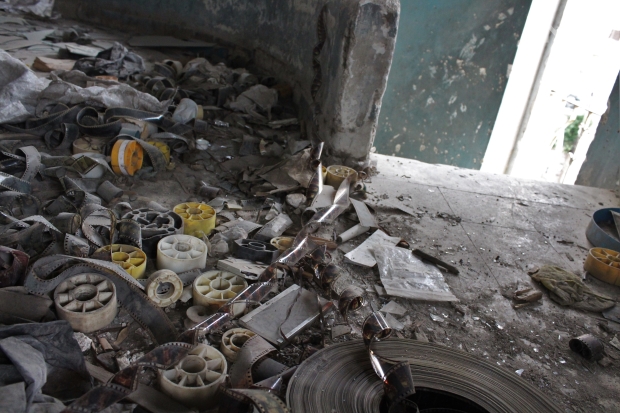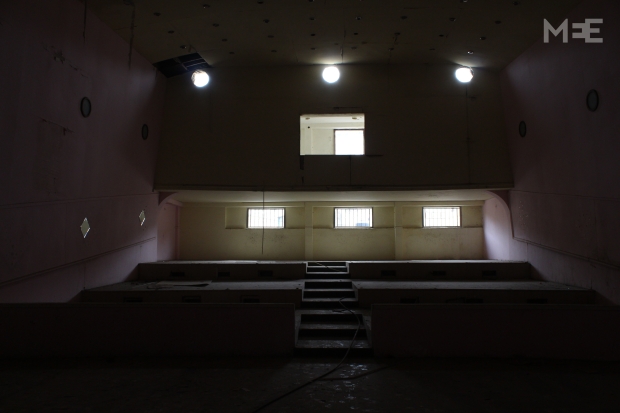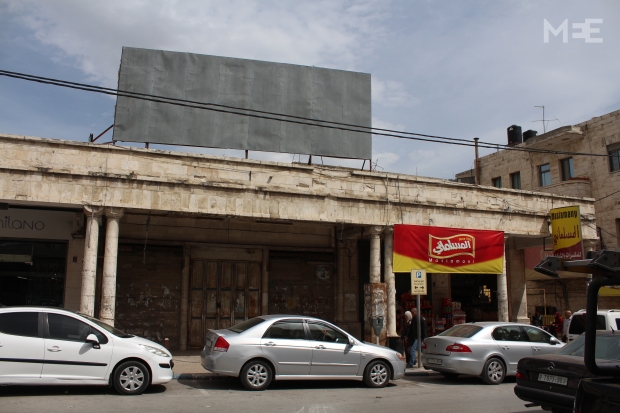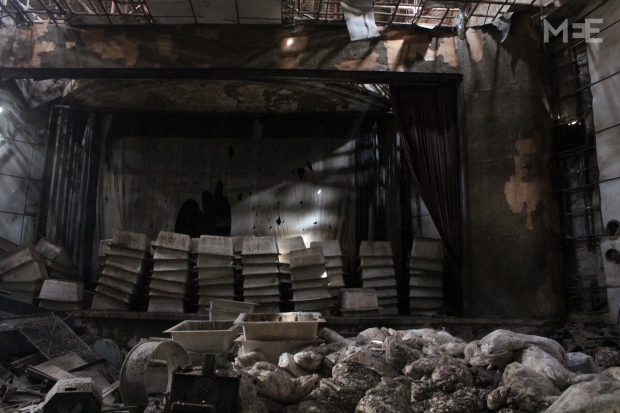Final curtain looms for ghost cinemas of Nablus
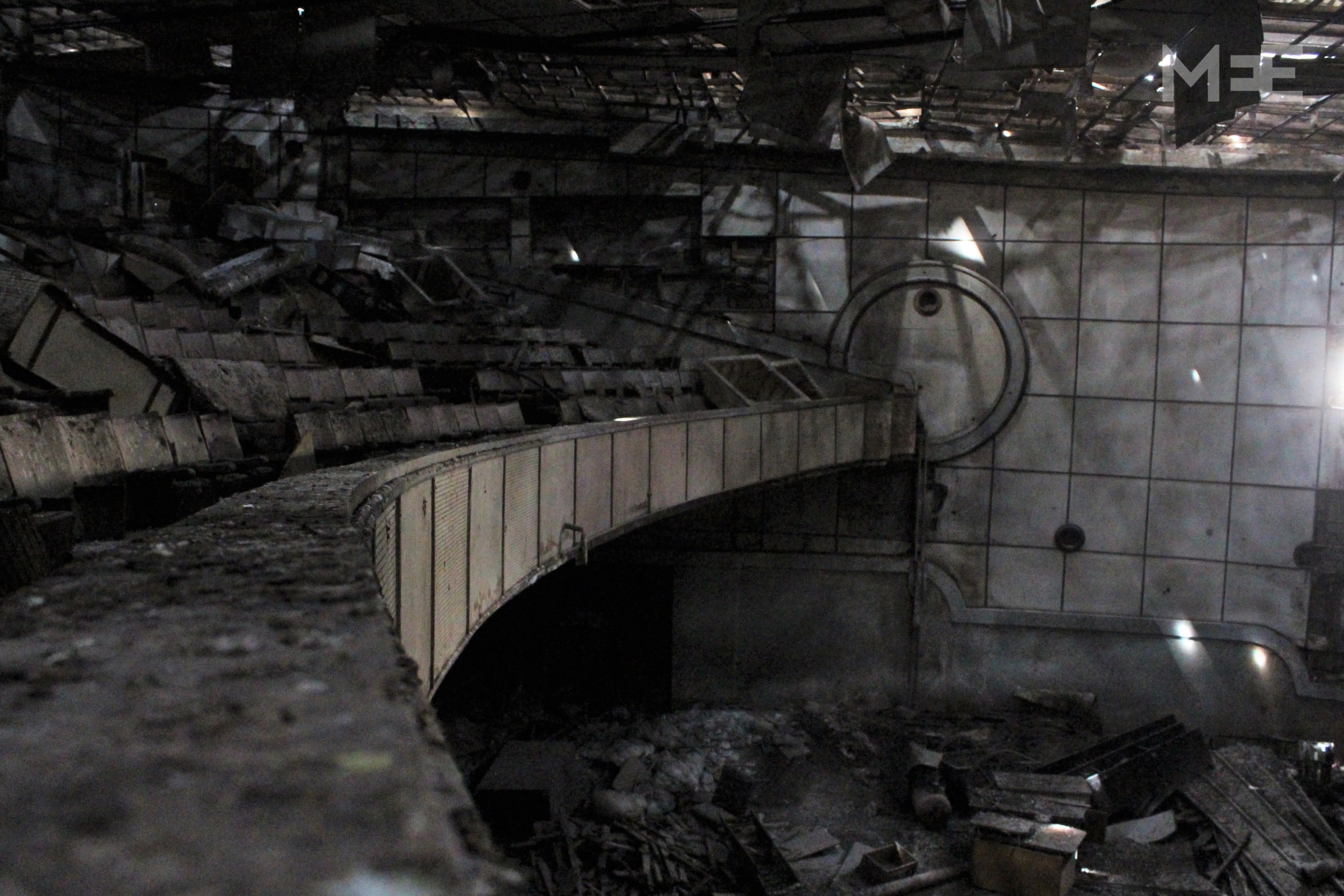
Walking up the steps of the old al-Assi cinema in the middle of the West Bank city of Nablus is a surreal experience; it is like walking onto a dusty, abandoned movie set.
The staircase leading up to the projection room is filled with traces of its past, almost to the point of caricature. Empty reels of all sizes rest against curved steps, and reams of film hang like translucent streamers over the balcony.
But this is no movie set – instead, it is quite the opposite. Cinema al-Assi opened in 1952 and once played host to the most popular films of the 1950s, 60s and 70s, drawing crowds from all over the West Bank who queued for a spot in the 600-seat auditorium. It closed when the First Intifada began in 1987, then re-opened in 1998, but after being shelled in 2002 during the Second Intifada, shuttered for good.
Today, a guard sits outside the old ticket window, and behind him, what once functioned as the staging area for the screen has become an open garage – a small, indoor parking area for nearby shopkeepers.
He tells curious passers-by that they need to contact Nablus municipality with any of their questions, but lets slip that the municipality is planning to demolish the building.
The guard, Mouniir Akoub, 64, is a lifelong Nablus resident, and has seen his share of crowds at al-Assi. He began working at the cinema as a teenager, earning his way through the ranks. In a strange twist of fate, he is now employed by the municipality to keep people out of the old cinema he once worked so hard to keep running.
“I’ve spent my whole life here,” Akoub said fondly, looking up at the cinema’s faded lettering. “I started as a junior employee, and worked my way up to become a manager. We used to show Indian, Arabic and Japanese films, all kinds of films.”
Two years ago, the Nablus municipality purchased Cinema al-Assi from the Assi family, going through a lengthy process of acquiring nearly 100 family members’ signatures to release the property.
A health inspection found asbestos in the ceiling and walls of the structure, rendering it a health risk. Analysing the cost and benefits, the municipality made plans to demolish the building to alleviate traffic on the main street that flanks the site, and create a parking and indoor/outdoor shopping area.
“This is not a historic building,” Raja Taher, Nablus municipality’s director of public relations explained when asked about the impending demolition. “It was built in the 1950s. We work to preserve buildings in the old city that are 100, 200, 300 years old, but this is not a historic building. It will become an open space, a one-stop shop. It will open the street and it will become a shopping centre, with a car park and street vendors for the people of Nablus.”
A mid-century love affair with film
Al-Assi is one of three cinemas that older Nablus residents point out when asked about the city’s mid-century love affair with film; the other two being Cinema Granada and Cinema Rivoli. All three of these cinemas played an important role in Nablus’ cultural and social landscape, and their structures still remain, showing hints of their former selves.
Cinema Rivoli was founded in 1952, and showed a variety of Egyptian, Indian and karate films, but was also closed when the First Intifada erupted in 1987. It re-opened a couple of times, but due to security concerns, permanently closed until 2000 when it was turned into a small shopping centre. The old ticket window is blocked by a green metal grate at the entrance to the mall, but aside from its lofty ceiling, little else inside the long hallway of shops gives away its former identity.
Cinema Granada, however, is another story. Privately owned by the al-Shakaa family, the cinema is now an unassuming shopfront, wedged between a sweet shop and a shoe store. Behind the padlocked metal doors, the cinema’s original fixings remain virtually unchanged with many of the 1,000 seats and large, maroon stage curtains still in place.
But where moviegoers once took in foreign films, toilets and bathtubs now fill the aisles. Since it closed in 1987, after the start of the First Intifada, the cavernous cinema has been used as a storage facility for sanitary products. The inside of the building is anything but sanitary – seemingly hundreds of pigeons have made the rafters of Cinema Granada their home, and over the past 29 years have left their mark on every surface of the interior.
Violence was the underlying factor in the closure of Nablus’ picture houses, but technological advancements during the 1980s and 90s also had an effect on the city’s cinema culture. The al-Shakaa family cites the growing popularity of the videocassette as another reason Granada closed its doors.
Patrons who once chose how much they wanted to pay to see a film in each of these cinemas - the more expensive seats were in the balconies, and the cheaper ones on the ground floor - could now watch films in the comfort of their living rooms.
When the old building that once housed Cinema al-Assi is demolished later this year, Akoub will be out of a 46-year job of keeping an eye on the building.
“It has been a pleasure for me to spend my life here,” Akoub said. “I’ve spent every day here. I can’t even describe how I feel about the fact that it will be gone soon.”
New MEE newsletter: Jerusalem Dispatch
Sign up to get the latest insights and analysis on Israel-Palestine, alongside Turkey Unpacked and other MEE newsletters
Middle East Eye delivers independent and unrivalled coverage and analysis of the Middle East, North Africa and beyond. To learn more about republishing this content and the associated fees, please fill out this form. More about MEE can be found here.


